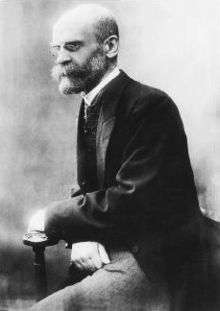Sacred–profane dichotomy
The sacred–profane dichotomy is an idea posited by French sociologist Émile Durkheim, who considered it to be the central characteristic of religion: "religion is a unified system of beliefs and practices relative to sacred things, that is to say, things set apart and forbidden."[1] In Durkheim's theory, the sacred represented the interests of the group, especially unity, which were embodied in sacred group symbols, or totems. The profane, on the other hand, involved mundane individual concerns. Durkheim explicitly stated that the sacred–profane dichotomy was not equivalent to good/evil. The sacred could be good or evil, and the profane could be either as well.[2]
Durkheim's claim of the universality of this dichotomy for all religions/cults has been criticized by scholars such as British anthropologist Jack Goody.[3] Goody also noted that "many societies have no words that translate as sacred or profane and that ultimately, just like the distinction between natural and supernatural, it was very much a product of European religious thought rather than a universally applicable criterion."[4]
As Tomoko Masuzawa explains in The Invention of World Religions: Or, How European Universalism Was Preserved in the Language of Pluralism, this system of comparative religion privileged Christianity at the expense of non-Christian systems (2005). Any cosmology without a sacred/profane binary was rendered invisible by the field of Religious Studies, because the binary was supposed to be ‘universal’.
See also
- Carnival and Carnivalesque
- Grotesque body
- Kegare
- Mircea Eliade
- Ritual and ceremony
- Sacred and Profane (8 medieval lyrics) (choral composition, by Benjamin Britten)
- Sacred and Profane Love (oil painting, by Titian)
- Social control
Notes
- ↑ Durkheim 1915, p. 47
- ↑ Pals 1996, p. 99
- ↑ "The sacred-profane distinction is not universal". Retrieved 2007-07-10. quote: "neither do the Lo Dagaa [group in Gonja, editor note] appear to have any concepts at all equivalent to the vaguer and not unrelated dichotomy between the sacred and the profane"
- ↑ "Sacred and Profane - Durkheim's Critics". Retrieved 2007-07-10.
Bibliography
- S. S. Acquaviva, Patricia Lipscomb The Decline of the Sacred in Industrial Society. review: JSTOR 1202830
- Mikhail Bakhtin, Mikhail. Rabelais and His World [1941]. Trans. Hélène Iswolsky. Bloomington: Indiana University Press, 1993.
- C. Renate Barber Sacred and Profane: Some Thoughts on the Folk-Urban Continuum of This Dichotomy Man, Vol. 65, Mar. - Apr., 1965 (Mar. - Apr., 1965), pp. 45–46 doi:10.2307/2797525 JSTOR 2797525
- Carsten Colpe, The Sacred and the Profane in the (Encyclopedia of Religion)
- Emile Durkheim, The Elementary Forms of the Religious Life, (1912, English translation by Joseph Swain: 1915) The Free Press, 1965. ISBN 0-02-908010-X, new translation by Karen E. Fields 1995, ISBN 0-02-907937-3
- Daniel Pals, Seven Theories of Religion. New York: Oxford University Press 1996. US ISBN 0-19-508725-9 (pbk).
